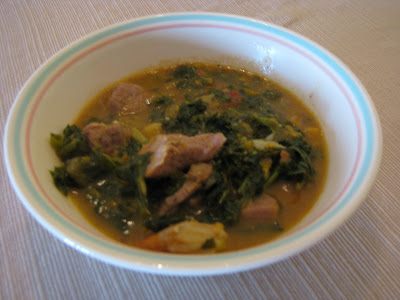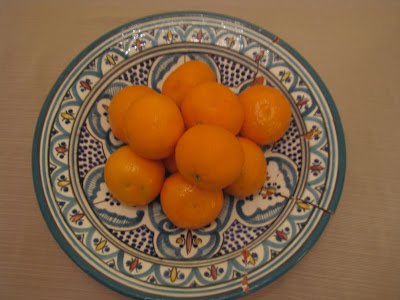
There's a lot to be said for a country where people spend much of the day lingering over coffee in the cafe, and then unwind in the evening with a nice glass of vino.
I had no idea Spain was so cut out for me when I went there. I had no way of knowing.
I ended up in Spain during my six-month semester abroad in college. There were two things I really wanted to do when I set my little heart on going to Syracuse for college: 1) Be the editor of the college paper and 2) Study abroad. But when I got to campus I realized I probably couldn't do both. Most people spent their entire college career working their way to the editor's office.
The universe, however, always has a strange way of orchestrating events in my favor. I ended up stepping up earlier than most people, giving me the opportunity to still study abroad if I wanted.
At that point, I wasn't sure. I flirted with the idea of extending my reign as editor. At least until it burned me out. I never expected the politics, drama, stress and tension that came with running a little 10,000 circulation paper with a bunch of extremely passionate, driven and in some cases certifiably crazy people.
I was barely halfway through my term when I realized I was ready for a siesta.
Originally, I figured I would go to London. That's where all the journalism majors went, and some of my friends would be there.
But being one for goal setting and planning ahead, I already knew at this point in my life I wanted to go to Florida. Given that, an editor I worked for during one of my internships raised a good point.
"If you want to go to Florida, don't you think it would be a good idea to learn Spanish," he asked.
Touche. SU also had a program in Madrid (I know, different dialect and all that ... but still better than English) and I started looking into it.
The photos of tiled arches, gothic churches, miles of orange groves and beautiful beaches lured me to the country. And after a few years running on three hours of sleep a night, I really liked this whole siesta prospect.
The reality was, in many ways, nothing what I expected.
I arrived in the country with a group of probably about 100 other college students, many of them from the Greek system and many of them not huge fans of the college paper (I had actually written up arrest reports on some of them). I didn't know anybody, and quite frankly didn't like most of them. I was lonely.
I was still feeling jet lagged when the culture shock started to sink in. I'm one for order. I like to know where I'm going. When my friends and I went on spring break in Chicago, I made up a schedule with a to do list for every day. In Spain, the group spent the first two weeks touring the country. I don't think I ever got an itinerary. I never had any idea where we were going. It drove me crazy.
They would just tell you to get on the bus at a certain time. I would always be there early, only to sometimes wait more than an hour for one of the Spanish tour guides to finish his coffee.
And the whole sleepytime thing was a myth. Turns out, Spanish people sleep less than I was at that point. They stay up into the wee hours of the morning (they don't even eat dinner until 10 p.m.) and then get up at like 6 in the morning. Siesta hardly makes up for it.
My mom kept telling me to just come home.
But eventually, I made a friend who was just as lonely and frustrated as I was. I remembered this semester was supposed to be fun and dropped my course load down to the bare minimum 12 credits I needed to be a full time student.
(This was actually really brilliant and strategic on my part. I needed one more science class for my degree, so I took the ecology of Spain, which involved learning about how Americans are destroying the earth and trips kayaking and horseback riding... I don't remember going to class after a while, but still got an A. Much better than physics or chemistry. I also knocked out a required foreign language credit and filled in the rest of the schedule with two literature classes that regularly met at the taverna to discuss writing over vino: Don Quixote and Hemingway in Spain... I cheated on Don Quixote and took the English version. I liked college better Spanish style.)
The rest of my days I spent in at the cafes. Mornings, I sat in the coffee shops reading for class or just people watching. In the evenings, I met up with friends (I did make some eventually) for tapas or vino. I'd go home at night and have dinner with my host family. Sometimes I just walked around the city taking it all in and thinking. I traveled. I found comfort in Harry Potter.
I went to Spain with a to do list of all the things I wanted to see and places I wanted to go in Madrid, but ended up putting it all off until the last week I was there. I quickly picked up the phrase "manana." I'll just get to it later. Just enjoying the simplicity of everyday Spanish life became more important.
Don't get me wrong. Six months hardly changes a person. It's still hard not to get caught up in the "where is my life going" and "am I on the right path." A few years ago when we finished a big project I started to stress about what life was going to bring me next. A co-worker quoted that cheesy line from the Matrix, something like "Don't worry where the path is going. Just walk to path."
But when I think about it now, I realize I learned that lesson a long time ago. I learned it from the Spanish. The hard part, sometimes, is honoring it.
One note on the photo, or lack thereof. All my travel photos are in Buffalo. At one point I scanned a bunch in so I could use them on the blog, but apparently forgot to include any from Spain. So I'll just get to it later : )
 Suriname sure sounds like one of those obscure places where an interesting meal could be hard to come by. At least that's what I thought. Talk about a misjudgment. The dish I served up from this South American country is probably one of my favorites since I started cooking my away around the world. Who knew!
Suriname sure sounds like one of those obscure places where an interesting meal could be hard to come by. At least that's what I thought. Talk about a misjudgment. The dish I served up from this South American country is probably one of my favorites since I started cooking my away around the world. Who knew!
















